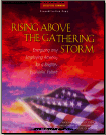 US
National Academies Issue Stark Warning to Their Federal Government on Support
for Science. (October 13, 2005)
US
National Academies Issue Stark Warning to Their Federal Government on Support
for Science. (October 13, 2005)
|
News & Views item - October 2005 |
 US
National Academies Issue Stark Warning to Their Federal Government on Support
for Science. (October 13, 2005)
US
National Academies Issue Stark Warning to Their Federal Government on Support
for Science. (October 13, 2005)
A 330 page report issued by a 20-member panel of the US National Academies titled Rising Above The Gathering Storm: Energizing and Employing America for a Brighter Economic Future has concluded that the U.S. government must spend an estimated US$10 billion more a year on basic research and training to compete in the global marketplace. The report emphasises that a burgeoning technical base in Asia coupled with subpar precollege science and math education in the United States are paramount issues.
The US congress requested the report from the academies in May. ScienceNow reports that, "[a]mong the recommendations... are 4-year undergraduate scholarships, worth up to US$20,000 a year, for students who then commit to spend 5 years teaching math and science in the public schools. The panel also recommended a 10% annual increase over the next 7 years in federal spending on basic research, effectively doubling the current level of $27 billion, with an emphasis on physical sciences. To aid industry, the group suggests reforms to the U.S. patent system and making permanent an expanded R&D tax credit."
With the US war budget continuing to increase and the cost of rebuilding the Gulf states after hurricanes Katrina and Rita coupled with the ballooning US national debt how much attention Congress will pay to the report is questionable.
But Norman Augustine former Lockheed Martin chairman and panel chair, said in a Washington, D.C. press conference, "Today we are very likely on a losing path," and when asked about the mammoth cost of the panel's recommendations said simply, "We believe we cannot afford not to [invest]," and added that the additional spending, would create new industries and jobs and "feed itself in the longer term."
The report lists many examples where the United States is falling behind other countries. In US schools, for example, only 41% of eighth-graders (13–14-year-olds) in 1999 had a maths teacher who had trained in maths, compared with an average of 71% internationally. And the situation for secondary schools in Australia?
In 2000, Jan Thomas, Executive
Officer, Australian Mathematical Sciences Institute, estimated that about
40% of teachers of mathematics instructing students in their first year of
Australian secondary schooling were under-qualified. While the estimate was
based on a small data sample the figure has not been challenged by the
Department of Education, Science and Training.
Whether or not US Congressmen and women have any longer vision than their Australian counterparts, who remain preoccupied with the ideological squabble over so-called voluntary student unionism, will be seen when the next US budget is considered.